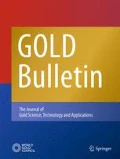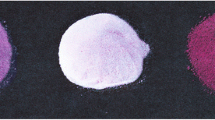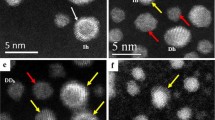Abstract
Work performed with gold catalysts before about 1980 is briefly reviewed, and early indications of the importance of using very small particles to obtain good activity are noted. The apparent contrast between silver and gold in catalysing carbon monoxide oxidation was anticipated by studies in matrix isolation chemistry. The unexpected and in some ways unique properties of gold are attributable to the operation of a relativistic effect which stabilises the 6s 2 electron pair. Essential requirements for high oxidation activity include: small particle size, use of ‘reactive’ support, and a preparative method that achieves the desired size of particle in intimate contact with the support. Surface atoms on such small particles behave more like individual atoms, and this together with awareness of the relativistic factor may help to explain why gold can be such an effective catalyst.
Similar content being viewed by others
References
K. Tanaka and K. Tamaru,J. Catal., 1963,2, 366
G.C. Bon and D.T. Thompson,Catal. Rev.-Sci.Eng., 1999,41, 319
G.C. Bond,J. Molec. Catal. A: Chem., 2000,156, 1
G.C. Bond,Plat. Met. Rev., 2000,44, 146
P. Pyykkö,Chem. Rev., 1988,88, 563
W.A. Bone and R.V. Wheeler,Phil. Trans., 1906,206A, 1
D.L. Chapman, J.E. Ramsbottom and C.G. Trotman,Proc. Roy. Soc. A, 1925,107, 92
A.F. Benton and J.C. Elgin,J. Am Chem. Soc., 1927,49, 2426
W.A. Bone and G.W. Andrew,Proc. Roy. Soc. A, 1925,109, 409
G.C. Bond,Gold Bull., 1971,5, 11
R.S. Yolles, B.J. Wood and H. Wise,J. Catal., 1971,21, 66
G.J. Hutchings,Gold Bull., 1996,29, 123
G.C. Bond and P.A. Sermon,Gold Bull., 1973,6, 102
P.A. Sermon, G.C. Bond and P.B. Wells,J. Chem. Soc., Faraday Trans. I, 1979,75, 385
G.A. Ozin,Acc. Chem. Res., 1977,21, 10
D. McIntosh and G.A. Ozin,Inorg. Chem., 1976,15, 2869; 1977,16, 51
M. Mavrikakis, P. Stolze and J.K. Norskov,Catal. Lett., 2000,64, 101
G.C. Bond and D.T. Thompson,Gold Bull., 2000,33, 41
H. Liu, A.I. Kozlov, A.P. Kozlova, T. Shida and Y. Iwasawa,Phys. Chem. Chem. Phys., 1999,1, 2851
Author information
Authors and Affiliations
Additional information
This paper was given as the opening keynote lecture at the ‘Catalytic Gold 2001’ Conference held in Cape Town, April 2001.
Geoffrey Bond held academic posts at Leeds and Hull Universities before joining Johnson Matthey plc in 1962 as Head of Catalysis Research. In 1970 he was appointed Professor in Brunel University’s Chemistry Department, and is now an Emeritus Professor: he has ‘Visiting’ appointments at the Universities of Salford and Surrey.
Rights and permissions
About this article
Cite this article
Bond, G.C. Gold: A relatively new catalyst. Gold Bull 34, 117–119 (2001). https://doi.org/10.1007/BF03214823
Issue Date:
DOI: https://doi.org/10.1007/BF03214823




